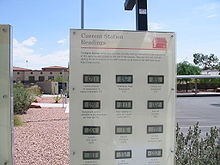- Roentgen (unit)
-
This article is about the unit of measurement. For Röntgen radiation, see X-ray. For other uses, see Roentgen.
The roentgen (R, also röntgen) is a unit of measurement for exposure to ionizing radiation (such as X-ray and gamma rays), and is named after the German physicist Wilhelm Röntgen. Adopted in 1928,[1] 1 R is the amount of radiation required to liberate positive and negative charges of one electrostatic unit of charge (esu or StatCoulomb) in one cubic centimeter of dry air at standard temperature and pressure (STP). This corresponds to the generation of approximately 2.0819×109 ion pairs.
The weather station outside of the Atomic Testing Museum on a hot summer day. Displayed background gamma radiation level is 9.8 μR/h which would be approximately 86 mR per year—less than typical. The station is part of the Community Environmental Monitoring Network(CEMP).
The unit is of a family of variant metric radiation units used largely in the United States. Related units are the rad, a measure of absorbed dose, and the rem, a unit of equivalent dose which adjusts for the impacts of different forms of radiation on biological matter.
Contents
Conversion
In SI units, 1 R = 2.58×10−4 C/kg (from 1 esu ≈ 3.33564×10−10 C and the standard atmosphere air density of ~1.293 kg/m³).[2]
Until 2006, a different roentgen was (confusingly) accepted for use with the SI system, with its value expressed in terms of the SI units charge divided by unit mass (coulomb/kg) rather than as in the original definition (statC/cm³). Although its use was allowable under the SI system, it is not itself an SI unit and its continued use is "strongly discouraged" by the National Institute of Standards and Technology style guide for NIST authors.[2]
Exposure
An exposure of 500 roentgens in five hours is usually lethal for human beings.
The typical exposure to normal background radiation for a human being is about 200 milliroentgens per year, or about 23 microroentgens per hour.
In human tissue, one Roentgen of gamma radiation exposure results in about one rad of absorbed dose (= 0.01 Gy). [3]
When measuring dose absorbed in man due to exposure, units of absorbed dose are used (the related rad or SI gray), or, with consideration of biological effects from differing radiation types, units of equivalent dose, such as the related rem or the SI sievert.
See also
- Wilhelm Conrad Röntgen
- Rad (unit) — c.g.s. unit of absorbed dose
- Gray (unit) — SI unit of absorbed dose
- Roentgen equivalent man, or rem, a unit of radiation dose equivalent
- Sievert — The sievert (symbol: Sv) is the SI derived unit of dose equivalent.
- Microdose
- Orders of magnitude (radiation)
References
- ^ Van Loon, R.; and Van Tiggelen, R., Radiation Dosimetry in Medical Exposure: A Short Historical Overview, 2004>
- ^ a b Taylor, BN, "Units temporarily accepted for use with the SI", NIST Guide for the Use of the International System of Units (SI), chapter 5, Physics Laboratory Publications, April 1995, retrieved and archived [1] 12th June 2008
- ^ Measures Relative to the Biological Effect of Radiation Exposure
External links
Categories:- Units of radiation dose
- Non-SI metric units
Wikimedia Foundation. 2010.

